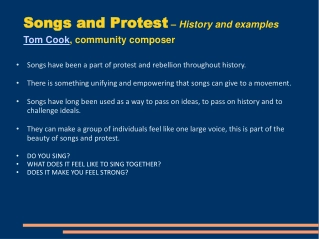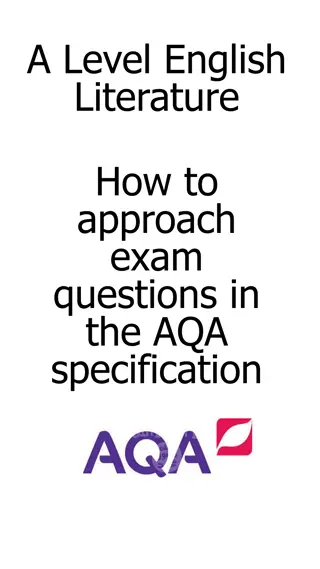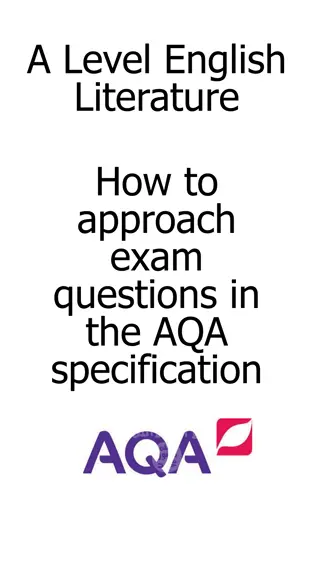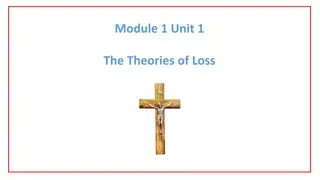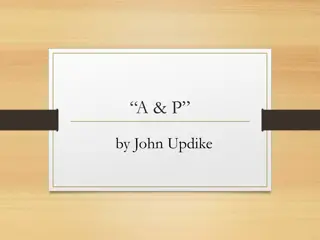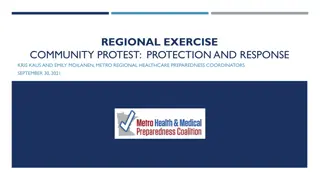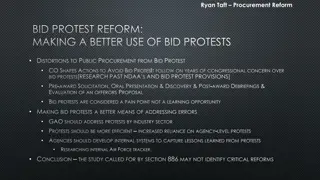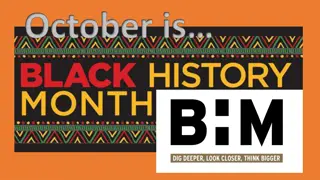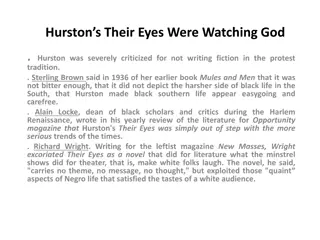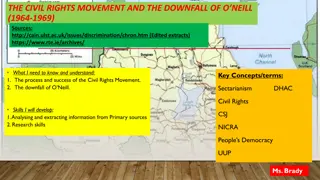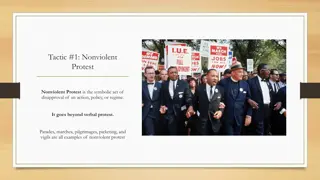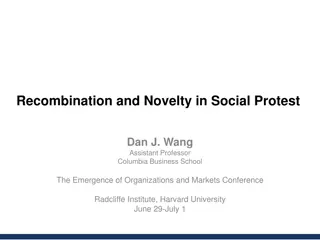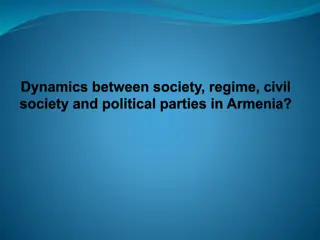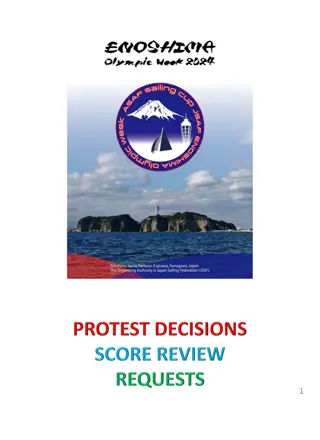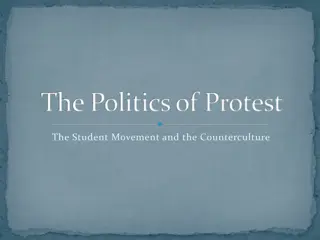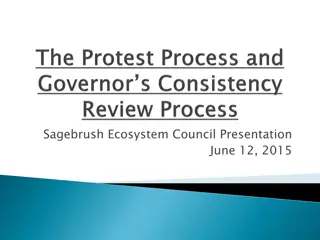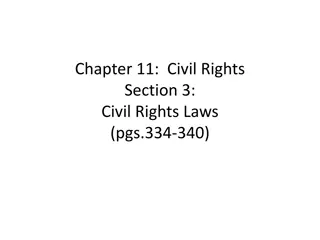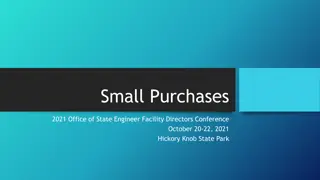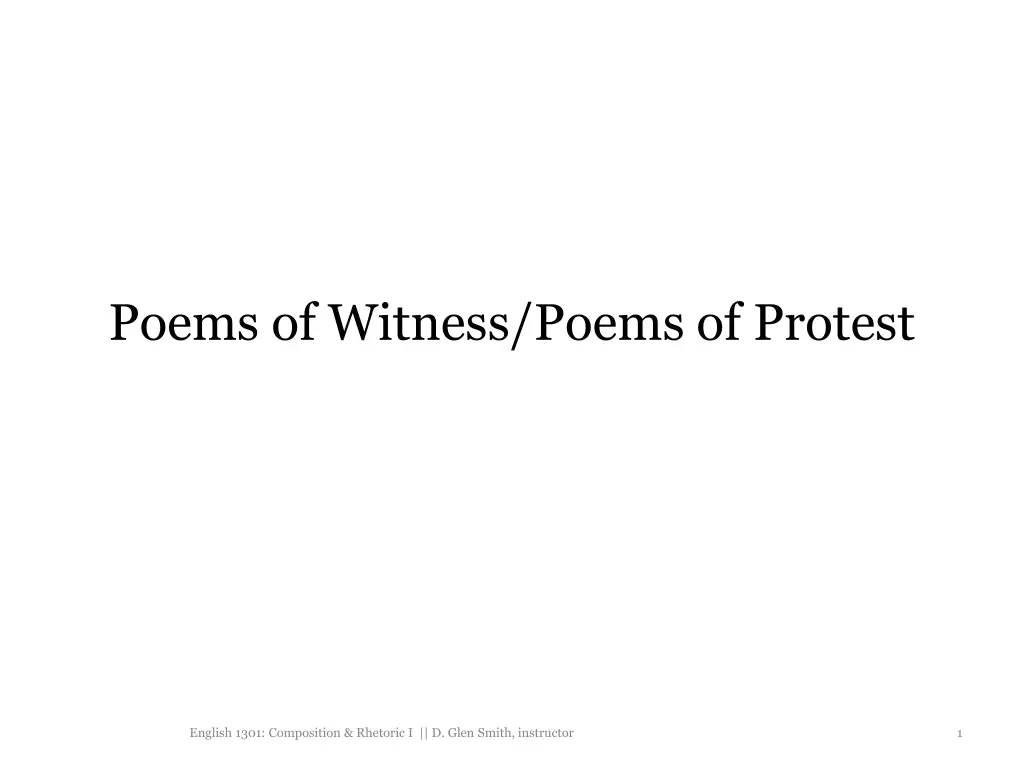
Understanding Protest Poetry in English Composition
Explore the essence of protest poetry in English Composition, examining the expression of societal change through poetic conventions, the role of persona versus poet, closed form versus open form poetry, and examples illustrating these concepts. Delve into the intricacies of protest poetry through the lens of renowned poets like W.H. Auden.
Download Presentation

Please find below an Image/Link to download the presentation.
The content on the website is provided AS IS for your information and personal use only. It may not be sold, licensed, or shared on other websites without obtaining consent from the author. If you encounter any issues during the download, it is possible that the publisher has removed the file from their server.
You are allowed to download the files provided on this website for personal or commercial use, subject to the condition that they are used lawfully. All files are the property of their respective owners.
The content on the website is provided AS IS for your information and personal use only. It may not be sold, licensed, or shared on other websites without obtaining consent from the author.
E N D
Presentation Transcript
Poems of Witness/Poems of Protest English 1301: Composition & Rhetoric I || D. Glen Smith, instructor 1
Definition Protest poem literary expression seeking change in society; much like the images projected about the early Sixties in the Twentieth Century with songs created by Joan Baez or Bob Dylan asking for change from the status quo for the common good; in the case of poetry, what we have is the poet witnesses an issue in society and he/she reflects upon the perceived injustice using poetic conventions English 1301: Composition & Rhetoric I || D. Glen Smith, instructor 2
Poet versus Persona In some cases, the persona of the poem is shown as an isolated figure, in the background, as a non-participatory character; he/she witnesses but does not act directly in the scenes provided. Because the persona cannot act or chooses not to act, the reader is therefore expected to be an agent of change and reform. Such poems in a sense ask for reactions on the part of the audience due to the persona s inability to affect change. English 1301: Composition & Rhetoric I || D. Glen Smith, instructor 3
Closed Form Generally speaking, poetry can be divided into two forms: closed forms or open forms. Closed form poetry follows a strict, traditional pattern and specific restrictions. Poet follows an expected formula with line count, rhyming techniques, and meter. English 1301: Composition & Rhetoric I || D. Glen Smith, instructor 4
Closed Form Example An Elizabethan love sonnet for example follows these basic rules: rhyme pattern (or rhyme scheme) of ABAB CDCD EFEF GG fourteen lines expected to have meter: iambic pentameter should contain a volta see the poem attributed to William Shakespeare, Sonnet #18 English 1301: Composition & Rhetoric I || D. Glen Smith, instructor 5
Open Form Open form poetry follows no formal pattern, no restrictions. The work is open for creative variations. Also referred to as free verse. Poem can rhyme if the poet desires, but it is not required. Poem can use meter if poet desires, but it is not required. Poem can use regularized stanzas if poet desires, but it is not required. See Lynda Hull s Lost Fugue for Chet English 1301: Composition & Rhetoric I || D. Glen Smith, instructor 6
W. H. Auden || The Unknown Citizen The Unknown Citizen is a protest poem discussing issues of complacency and non-action by citizens in a dystopian environment. See Current Issues, p. 691 The poem raises images similar to conditions and situations in Germany during the years prior to World War II. The work was written published in 1940. English 1301: Composition & Rhetoric I || D. Glen Smith, instructor 7
W. H. Auden || The Unknown Citizen The poet is not the narrator. The persona in this case is a member of a controlling governmental agency. He does not react to the scene he unemotionally reports, he merely relates the history of an unknown man, a figure without true identity. English 1301: Composition & Rhetoric I || D. Glen Smith, instructor 8
W. H. Auden || The Unknown Citizen This work is considered open form. It does not contain a steady rhythm or standard meter. However, the lines do rhyme albeit the full poem lacks a formal rhyme scheme. English 1301: Composition & Rhetoric I || D. Glen Smith, instructor 9
Use of Rhyme A B A B A be complaint agree saint community H H insured cured I J J I K I K declare plan man Frigidaire content year went C C D E E F F D retired fired inc views dues sound found drink L L L population generation education G G day way M M absurd heard English 1301: Composition & Rhetoric I || D. Glen Smith, instructor 10
Comparison of Meter Shall I compare thee to a summer s day? shall I / compare / thee to / a sum / mer s day perfect iambic pentameter He was found by the Bureau of Statistics to be One against whom there was no official complaint he was / found by / the bur / eau of / statis/ ics to / be awkward iambic rhythm- shifts to trochaic English 1301: Composition & Rhetoric I || D. Glen Smith, instructor 11
W. H. Auden The Unknown Citizen https://www.poets.org/poetsorg/poem/unknown-citizen English 1301: Composition & Rhetoric I || D. Glen Smith, instructor 12
Strategy of Audens First Line The awkward nature of the opening line serves a major purpose in this work. the lack of traditional, recognizable patterns reflects the awkward, confusing notion of the poem s main theme which discusses a character s lack of identity under a controlling, oppressive government English 1301: Composition & Rhetoric I || D. Glen Smith, instructor 13
Audens Epigraph The opening epigraph reads: (To JS/07/M/378 This Marble Monument Is Erected by the State) Typically an epigraph offers further insight, or offers in depth commentary to a literary work. In a few weeks we will bump into another use of this device when we read T. S. Eliot s long poem: The Love Song of J. Alfred Prufrock. English 1301: Composition & Rhetoric I || D. Glen Smith, instructor 14
Audens Epigraph The confusing arrangements of words do provide some sense of clues, ironically. From these three lines we can begin resolving the setting. We are standing in front of a marble statue memorializing a figure who is being honored by an unnamed government. Notice the resulting list of unknowable information: Who is the Citizen? Who is the persona narrating the story? Why is he narrating the story? What country? A reader can fall into quick confusion because the first line of the epigraph itself appears as a coded reference. English 1301: Composition & Rhetoric I || D. Glen Smith, instructor 15
Strategic Setting> Theme The more one reads the poem, the more the setting slowly reveals more details: an over-controlling government, simply referred to as the State in the epigraph as a result a theme emerges, discussing how an over-abundant governmental bureaucracy cripples and hinders individualism the Unknown Citizen is not intended to own a full identity. The lack of name, date, or recognizable geography adds a sense of unsettling and strategic distance between the reader and the poem. English 1301: Composition & Rhetoric I || D. Glen Smith, instructor 16
Overall Message The work is similar to the themes expressed in 1984 by George Orwell or Brave New World by Aldos Huxley who depict situations of dystopian futures for a fractured society. Characters in these novels are depicted as dehumanized individuals. Notice every act by the unknown citizen is tracked and recorded. He is followed where ever he goes. English 1301: Composition & Rhetoric I || D. Glen Smith, instructor 17
Satire W. H. Auden is generating a poetic satire as a means of projecting his warning about government control over the individual. Notice the proper nouns that run throughout the poem: Bureau of Statistics Greater Community War Fudge Motors Union Social Psychology The Press Health-Card Producers Research High-Grade Living Installment Plan Public Opinion Eugenist (The last is a person who is in control of improving the human population through genetic control, government supervision of marriage s and proper breeding.) English 1301: Composition & Rhetoric I || D. Glen Smith, instructor 18
The Unknown Citizen Characterized Looking at the full poem, what can we say about this Unknown Citizen? What did he do to deserve the monument in the first place? some clues can be gained if we slowly piece together details from each line English 1301: Composition & Rhetoric I || D. Glen Smith, instructor 19

